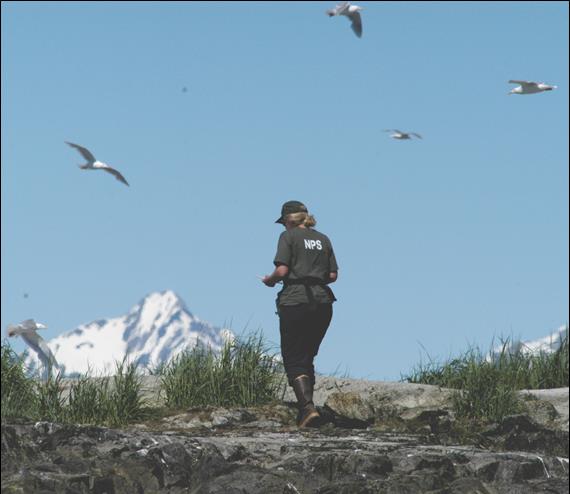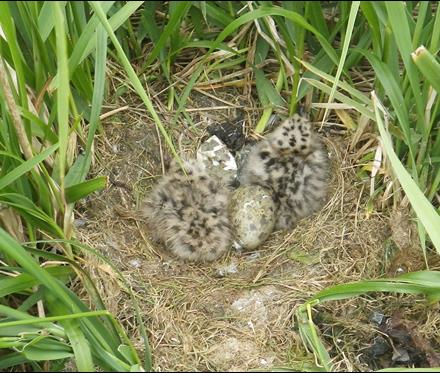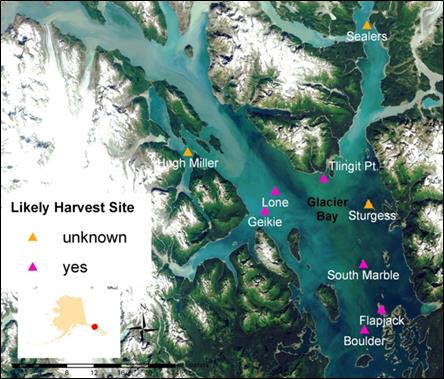What are the important things to measure if you care about the long-term health of shoreline-nesting birds?
Project Dates
May 2012 - December 2014
Did You Know?
Glaucous-winged gulls are “indeterminate” layers. They typically lay three eggs per clutch, and will respond to the loss of eggs to predation, harvest or other factors by laying more.
Introduction

Glacier Bay National Park and Preserve is home to at least 13 bird species that nest on the ground near the marine shoreline from May to August. Shoreline-nesting birds are vulnerable to human disturbance that may decrease productivity and ultimately population levels. About 15 islands within Glacier Bay proper are closed seasonally to protect nesting birds. This study will develop protocols for monitoring these birds, including impacts related to possible future authorized harvest of gull eggs by members of a local native tribe.
Efforts are underway to allow native subsistence harvest of glaucous-winged gull eggs on some of the currently closed islands. Congressional authorization is required, and legislation has been introduced. The traditional Huna Tlingit springtime egg harvest in Glacier Bay was curtailed in the 1960s as both the Migratory Bird Treaty Act and NPS regulations prohibited it. In the late 1990s the NPS, awakened to the cultural importance of the Huna Tlingit ties to their ancestral homeland, agreed to explore ways to allow the resumption of this traditional activity in the park. A Legislative Environmental Impact Statement (LEIS) was developed and finalized in 2010. Among other things, the LEIS mandates that the NPS develop a monitoring plan to inform a yearly traditional harvest and ensure that harvest activities do not impact park purposes and values.
The LEIS Record of Decision authorizes harvest at up to five locations on two separate dates each summer, with the first harvest occurring on or before the fifth day following onset of laying to allow time for the gulls to re-lay. Legislative authorization is still pending. If legislation passes Congress this year, the NPS will need to finalize regulations governing the harvest, including monitoring protocols.
Methods

In 2013 the researchers are conducting a full census of harvestable (accessible) glaucous-winged gull nests to determine the distribution, abundance, and contents of nests across the nesting season. Surveys are also attempting to determine nesting onset date, hatching date, and predation effects for each location.
The presence of other species including marine mammals and other bird species that could potentially be impacted by harvest activities are documented. GPS locations of nests are collected to accurately determine the distribution of nesting and to test for vegetation and landcover correlations.
Findings

In 2012 the researchers developed methods and protocols for long-term monitoring of shoreline-nesting birds. May-July 2012 were unusually cold and wet months, and the number of eggs appeared to be relatively low. Predation was quite extensive; in some locations the researchers found more predated than un-predated eggs. Crows and bald eagles were present at all potential harvest sites and were in larger numbers on forested islands.
Marine mammals regularly haul out at most of the sites. Access to the north end of South Marble Island and the small island to the south was restricted by the presence of Steller sea lions, and access to Geikie Rock and Lone Island was often precluded by the presence of harbor seals, even at high tide.
Onset of egg-laying did not appear to be synchronous across sites within Glacier Bay. This may complicate determining the timing of allowable egg harvest.
Some currently-closed locations were found to no longer have nesting colonies, while colonies have developed at some new, currently unprotected locations.
Last updated: September 15, 2016
